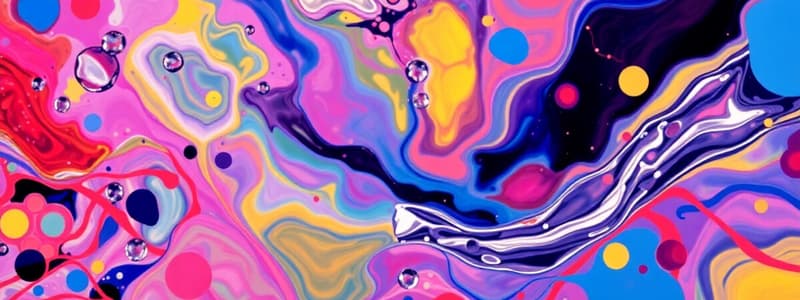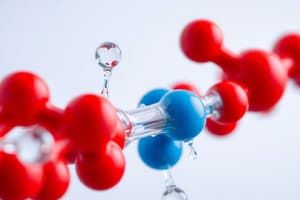Podcast
Questions and Answers
What percentage of the human body is comprised of water?
What percentage of the human body is comprised of water?
- 50%
- 80%
- 60%
- 70% (correct)
Which property of water allows it to dissolve many substances?
Which property of water allows it to dissolve many substances?
- Oleophobic nature
- Polar molecular structure (correct)
- High boiling point
- Hydrophobic nature
What is the term for compounds that easily dissolve in water?
What is the term for compounds that easily dissolve in water?
- Hydrophilic (correct)
- Lipophilic
- Hydrophobic
- Ionic
What occurs during osmosis?
What occurs during osmosis?
Which of the following is NOT a property of water?
Which of the following is NOT a property of water?
What does it mean if a solution is hypotonic compared to blood?
What does it mean if a solution is hypotonic compared to blood?
What causes the high boiling point of water?
What causes the high boiling point of water?
What term describes water molecules that do not dissolve in water?
What term describes water molecules that do not dissolve in water?
What is the primary function of buffers in biological systems?
What is the primary function of buffers in biological systems?
Which acid-base pair is commonly identified as a buffer system in the blood?
Which acid-base pair is commonly identified as a buffer system in the blood?
What characteristic distinguishes strong acids from weak acids in terms of ionization?
What characteristic distinguishes strong acids from weak acids in terms of ionization?
What is the physiological pH range maintained in human blood?
What is the physiological pH range maintained in human blood?
Which component is required as part of a buffer system?
Which component is required as part of a buffer system?
How does the bicarbonate buffer system help regulate blood pH?
How does the bicarbonate buffer system help regulate blood pH?
Proteins serve as important buffers primarily because they can:
Proteins serve as important buffers primarily because they can:
What would happen to blood pH without an effective buffer system?
What would happen to blood pH without an effective buffer system?
What is the pH of a neutral solution at 25°C?
What is the pH of a neutral solution at 25°C?
What does an acid do to the concentration of hydrogen ions in a solution?
What does an acid do to the concentration of hydrogen ions in a solution?
What characterizes a strong acid?
What characterizes a strong acid?
What is the relationship between pH and hydrogen ion concentration?
What is the relationship between pH and hydrogen ion concentration?
What is the behavior of weak acids in water?
What is the behavior of weak acids in water?
At what pH range is a solution considered acidic?
At what pH range is a solution considered acidic?
What role does a base play in a solution?
What role does a base play in a solution?
Which of the following describes a strong base?
Which of the following describes a strong base?
Flashcards
Hypertonic Solution
Hypertonic Solution
A solution with a higher concentration of solutes compared to blood, causing water to move out of cells.
Osmosis
Osmosis
The process where water molecules move across a semi-permeable membrane from a region of high water concentration to a region of low water concentration.
Osmotic Pressure
Osmotic Pressure
The ability of a solution to attract water molecules across a semi-permeable membrane.
Protonation
Protonation
Signup and view all the flashcards
Deprotonation
Deprotonation
Signup and view all the flashcards
Acid
Acid
Signup and view all the flashcards
Base
Base
Signup and view all the flashcards
pH Scale
pH Scale
Signup and view all the flashcards
Acid Dissociation Constant (Ka)
Acid Dissociation Constant (Ka)
Signup and view all the flashcards
Buffer
Buffer
Signup and view all the flashcards
Buffering Capacity
Buffering Capacity
Signup and view all the flashcards
Protein Buffers
Protein Buffers
Signup and view all the flashcards
Carbonic Acid-Bicarbonate Buffer System
Carbonic Acid-Bicarbonate Buffer System
Signup and view all the flashcards
CO2 Regulation of Blood pH
CO2 Regulation of Blood pH
Signup and view all the flashcards
Cellular Respiration
Cellular Respiration
Signup and view all the flashcards
Aerobic Respiration
Aerobic Respiration
Signup and view all the flashcards
Importance of Water
Importance of Water
Signup and view all the flashcards
Water is a Polar Molecule
Water is a Polar Molecule
Signup and view all the flashcards
Hydrogen Bonds in Water
Hydrogen Bonds in Water
Signup and view all the flashcards
Water as a Solvent
Water as a Solvent
Signup and view all the flashcards
Isotonic Solution
Isotonic Solution
Signup and view all the flashcards
Study Notes
Water, pH, and Buffers
- Water is essential for life, serving as the medium for life processes.
- Earth's surface is approximately 73% covered by water, and all living things rely on it.
- The human body is comprised of over 70% water, a key component of bodily fluids (e.g., blood, urine, saliva).
- Water plays a vital role in the chemistry of life; almost all chemical reactions happen in an aqueous environment.
- Water dissolves nutrients, making them easily transportable.
- Proteins, polysaccharides, nucleic acids, and membranes adopt specific shapes in response to water's properties.
- Water's chemical properties are directly linked to the functions of biomolecules, entire cells, and organisms.
- Water possesses two crucial properties: physical and chemical.
Physical Properties
- Water is a polar molecule.
- Two hydrogen atoms covalently bond with one oxygen atom.
- This creates an asymmetrical distribution of charge; one side is partially positive, and the other is partially negative.
- Due to this polarity, water is a good solvent for many substances.
Hydrogen Bonds
- Water's unusual properties arise from hydrogen bonds between water molecules and between water and polar solutes.
- Each water molecule forms four hydrogen bonds.
- This explains water's high boiling point, melting point, and surface tension.
Water as a Solvent
- Water is an excellent solvent, dissolving a wide range of organic and inorganic molecules.
- Hydrophilic ("water-loving") compounds readily dissolve in water, while hydrophobic ("water-fearing") compounds (e.g., lipids, waxes) do not.
- This relates to the functions of biomolecules, entire cells, and organisms.
Osmosis
- Osmosis is the movement of water across a semipermeable membrane from a region of higher water concentration to one with lower water concentration.
- Maintaining proper hydration is vital for proper bodily function.
Isotonic, Hypotonic, and Hypertonic Solutions
- Isotonic solutions have the same osmotic pressure as blood.
- Hypotonic solutions have lower osmotic pressure than blood.
- Hypertonic solutions have higher osmotic pressure than blood.
Chemical Properties (Ionization)
- Water slightly ionizes into hydrogen ions (H+) and hydroxide ions (OH−).
- At 25°C, the concentrations of H+ and OH− are equal (1 × 10−7 M).
- The concentration of water is a constant (55.5 M).
pH
- pH is a shorthand measure of the concentration of hydrogen ions (H+) in a solution.
- The pH scale is logarithmic (inverse logarithm), ranging from 0 to 14.
- pH values below 7 are acidic, and those above 7 are basic.
- pH values in cells and blood are close to neutral; extreme values are generally detrimental.
Acid
- An acid increases the concentration of hydrogen ions (H+) in a solution, often by releasing hydrogen atoms.
- Acids are proton donors.
Strong and Weak Acids
- Some acids completely ionize (strong acids) while others do not (weak acids).
- Strong acids undergo irreversible reactions, while weak acids are reversible.
Base
- A base increases the concentration of hydroxide ions (OH−) in a solution or reduces hydrogen ions (H+).
- Bases are proton acceptors or hydroxide donors.
Strong and Weak Bases
- Strong bases completely dissociate into ions.
- Weak bases do not fully ionize.
Ionization Constants of Acids (Ka)
- Ka measures an acid's ability to dissociate.
- Strong acids have high Ka values and dissociate completely in water.
- Weak acids have low Ka values and only partially dissociate.
Physiological pH
- It's crucial to maintain a stable pH within the human body.
- This is achieved by the use of buffers.
- Inside cells, the pH is roughly 7, and for blood it is 7.4 ± 0.05.
Buffers
- Buffers are solutions of a weak acid and its conjugate base, or a weak base and its conjugate acid.
- They resist changes in pH by absorbing excess H+ or OH-.
- Buffers facilitate body stability, preventing large pH fluctuations.
Buffer Systems in the Body
-
Proteins are the body's primary intracellular buffers.
-
Phosphate buffers are primarily found within cells.
-
Carbonic acid(H₂CO₃), bicarbonate(HCO₃⁻) and carbon dioxide (CO₂) act as critical buffers in the blood.
-
Maintaining constant blood pH is necessary for proper bodily functions.
-
The buffering system in blood prevents drastic fluctuations.
Studying That Suits You
Use AI to generate personalized quizzes and flashcards to suit your learning preferences.



